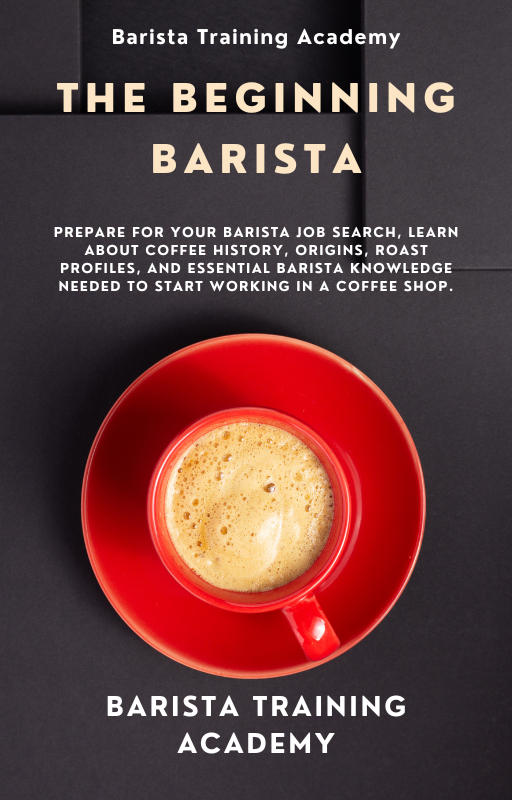Barista Training Quiz
Barista Training: Test Your Barista Knowledge
Quiz 3 – Barista Training Quiz Answers
1. If the coffee is grown at high altitudes, it shows more…
a. Acidity
There are plenty of factors that impact the taste and flavor of the coffee. Coffee origin, the type of soil it was growing on, and even the weather can alter the coffee taste. For example, if the coffee was grown at high altitudes, which slow the development of the coffee fruit. Such coffee plants have a denser and harder bean and display more acid flavor characteristics. Learn more about how the coffee is grown and processed here.
2. After steaming the milk, you get too many thick and airy bubbles. What did you do wrong?
b. you introduced too much air to your milk while stretching
When you stretch your milk, you add more air into it and create large bubbles. Later, when you submerge the steam wand deeper into the milk, you create a vortex that breaks down these big bubbles gives your milk creamy foam that is so much desired by cappuccino lovers. Improve your milk steaming skills with us here.
3. Where did the name Java come from?
c. Named after the port of origin, the Indonesian island of Java
Java is often used as a synonym for coffee. Actually, Java is a real place; it is the main island in Indonesia. If you read our “The Beginning Barista” book, you know that the Dutch began to grow coffee on the island of Java in the 16th century. The successful coffee trade resulted in the word “Java,” becoming a nickname for the coffee beans. You can get the very affordable “The Beginning Barista” book.
Barista Training Quiz Continued
4. Which coffee roast has the most caffeine?
a. Light roast
The caffeine level decreases as the roast is getting darker. The more you roast the beans, the more caffeine is roasted out. That is why lighter roasted coffee retains more caffeine. Read more about various coffee profiles and their characteristics here
5. What variables DON’T impact the taste of coffee?
c. The wi-fi connection in the coffee shop
Coffee contains over 1000 different flavonoids that can change the taste of the coffee. Practically anything can impact the taste of coffee, even the coffee shop's temperature, and humidity level. Read more about coffee variables and coffee flavor here.
6. In manual coffee brewing, the longer you brew your coffee…
b. the coarser the grind should be
For brews with longer coffee and water contact, you use a coarser grind. For example, if you brew coffee in a French press, you use the coarsest grind because coffee and water are mixed for the longest time here. This time is enough to extract all coffee flavor out of the grind. The finest ground is used to brew coffee in A Turkish coffee pot named cezve. Read more about manual coffee brewing here.
7. One of the most convenient leveling techniques is…
c. North, South, East, and West
Leveling facilitates even compression of the grounds during tamping, and you can’t avoid it when preparing espresso. There are a couple of popular leveling techniques:
- Twist and turn your finger to move coffee around the basket, or
- Level your coffee in the direction of North, then South, then East and West with your finger.
Choose the technique that best works for you here.
8. What is coffee extraction?
a. A process of removing mass from the coffee grounds
Coffee extraction is a process of removing soluble substances in coffee with hot water channeled under very high pressure. Soluble solids add to what we taste and the brew strength, while the soluble gasses add to what we smell or the aroma of coffee. The insoluble elements of coffee stay in the form of oils and fats visible on the group screen of the espresso machine. Read more about the importance of correct espresso extraction techniques here.
9. If the espresso extraction time is too long…
c. Grind your coffee coarser
One of the most common mistakes among beginning baristas is incorrect grind adjustment. It’s important to learn to play around with various grind adjustments to dial in your espresso. If the coffee is too fine or tamped too hard, water can’t flow through the grounds correctly. Learn more about dialing-in your espresso here.
10. What is NOT a coffee descriptor?
c. Antipathy
Coffee is a vibrant drink, which is even more complex than wine. There are many descriptors to use when you are trying to describe coffee. You might want to consult Coffee taster’s flavor wheel and visit coffee cuppings to learn how to articulate your own senses better. Still, some general concepts come to coffee taste like bitterness, acidity, aroma, and body. Learn more about how to describe your coffee here.

Barista Training Academy
Brought to you by Barista Training Academy. “The Beginning Barista” Your Ultimate Prep Guide to Getting Your First Job as a Barista” is an ultimate resource that is available online. It is affordable for anybody who is looking to start a career in the coffee industry. For more information, visit our blog.
